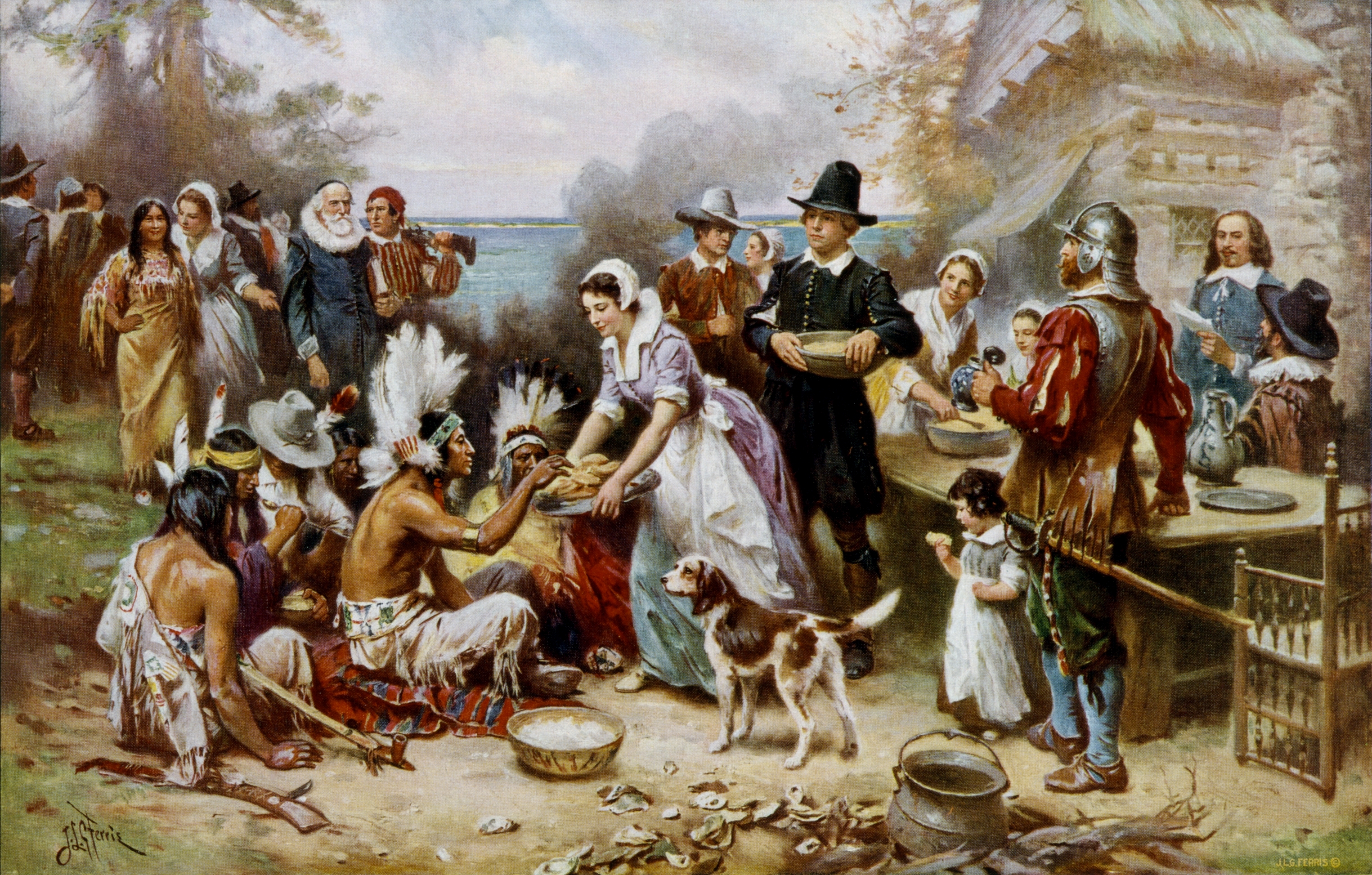This post has been read 2292 times!
 November 21, 2016- by Steven E. Greer
November 21, 2016- by Steven E. Greer
We have been celebrating Thanksgiving as an official federal event since George Washington issued a proclamation in 1789. Lincoln made it an official federal holiday in 1863. What are the actual events that led to the creation of this unique American event?
The true story of the Plymouth Pilgrims and the first Thanksgiving is fascinating. The Pilgrims landed in 1620, long after the 1607 Jamestown colony was started. Also, Europeans had been landing in what is now New England long before the Pilgrims. And yet we think of Plymouth as America’s first settlement. Why?
If the Pilgrims only knew what hardship the Jamestown colonists were enduring, they might have turned back. Down in Jamestown, 7000 people had died, leaving only 1000 or so remaining, and the weather was far more hospitable than Plymouth.
The Pilgrims were not people sent by the government of England, or any other nation. This was not like Columbus, who was sponsored by King Ferdinand of Spain, for example. Rather, they migrated to North America because they were Puritan separatists from the Church of England and were seeking some place to create a more pure religious environment. Also, an economic depression in England caused by several years of bad harvests was a catalyst.
Starting around 1607, the King of England, King James II, who also ran the Church of England, started to crack down on separatists, forcing the Pilgrim clan to flee into Holland. Being foreigners there who did not speak the language, they took hard factory jobs making textiles. They had been wealthy landowners in England.
After 10-years in Holland, the Thirty Years’ War began throughout most of Europe. So, the outcast Pilgrims had to look for somewhere else to go, once again.
Somehow, the Pilgrims found an investor from London named Thomas Weston who bought the Mayflower and it’s sailing crew for them (The Elon Musk of his day?). In exchange, the Pilgrims were supposed to send back wealth from the colony. Weston’s co-investors insisted that non-Puritans be part of the crew, so they sailed among impure strangers.
After a smaller ship that was also supposed to make the trip started to leak, they all piled into the Mayflower. There were only 102 people on board, and half of them were Pilgrims. The Mayflower was a 100-foot reliable merchant vessel.
On September 6th, 1620, The Mayflower left port in England heading for America. They were fighting the Gulf Stream and headwinds averaging two miles per hour. After 65-days at sea, suffering from scurvy, The Mayflower landed off of Cape Cod on November 9th. But they quickly realized that they were way off course, as they were trying to reach the Hudson River in what is now New York. But tough weather made them scrap those plans, and they went around Cape Cod and set anchor on November 11th.
Because they were so far off course, the Pilgrims felt that they were no longer guided by the contract they had made with Thomas Weston’s group. They almost split off on their own. Instead, they ended up compromising and formed their own government with rules that would allow the two different parties to get along.
William Brewster was probably the architect of that early constitution called The Mayflower Compact. John Carver was elected as the first governor.
Surprisingly, the Pilgrims were still loyal to King James, even though he is who drove them away. However, separation of church and state was an important principal of the Plymouth government.
After scouting out the area, they landed in December on the mainland at what the Native Americans called Patuxet, to be renamed Plymouth. They started to build crude houses, but they were unsuccessful in the cold. As Winter set in, they started to die by the dozen. By Spring, half were dead.
Plymouth was not the legally allowed landing spot on the Hudson they had planned on, but it happened to be in an area where all of the Native Americans had recently died from a plague started by previous Europeans. In March, one of the surviving Wampanoag Indians who spoke English, a man name Samoset, came to the Pilgrims’ camp to make peace and form an alliance. Their own population was dying from the plague and they needed help defending against the numerous other tribes in the region.
On April 5th, 1621, the Mayflower sailed back to England, leaving just the Puritan Pilgrims. It was sold for scrap shortly later.
In the Fall of 1621, the Wampanoag Indians and the Pilgrims got together to share their successful harvest, which was the first Thanksgiving (It was not called Thanksgiving by the Pilgrims). Turkey was indeed likely one of the main entrees, as were venison and corn.
William Bradford, who became the governor of Plymouth for three decades, was recording the history of Plymouth in his sizable book of memoirs and poetry (he even learned Hebrew later in life to be closer to god and the scriptures). That is one reason why America has come to think of Plymouth as the founding settlement.
On November 9th, 1621, a ship landed sent by Thomas Weston to re-supply the Pilgrims, and it brought 30 more people to feed, without enough supplies. Worse yet, they were just businessman trying to set up a competing trading post (and ended up failing).
Sometime after 1626, the Pilgrims in Plymouth started to find beaver pelts up in Maine and make a bit of a living selling them back to England, but the original investment group of Thomas Westin went bankrupt. However, Plymouth’s beaver pelts gave businessman back in England the idea to send thousands of more settlers. That is how Boston was founded in 1630. Those Bostonians were also Puritans, so the Pilgrims eventually succeeded in their goal of creating a new Puritan land.
William Bradford’s book of Plymouth history was lost for almost 100 years when British soldiers stole it during the Revolutionary War. When it was found, printing presses existed, and it became widely circulated right before the Civil War. There was a pop-culture Pilgrim craze amongst Northerners due to the fascinating history and the fact that the Pilgrims were against slavery. Being the good politician, Abraham Lincoln created the holiday of Thanksgiving.
Because Jamestown was a slavery colony and part of the defeated Confederate states, Plymouth became known as America’s first colony. It also helped that William Bradford wrote the history. History is written by the victors.
